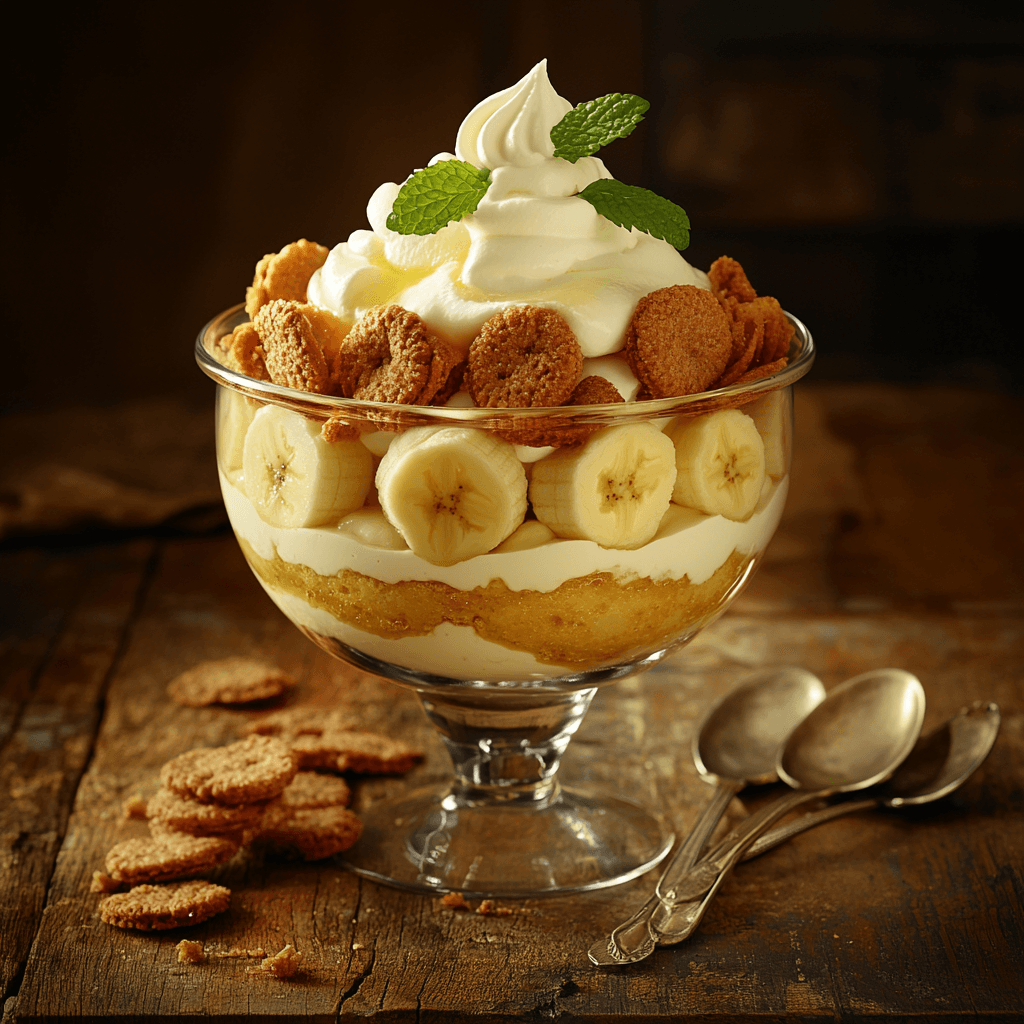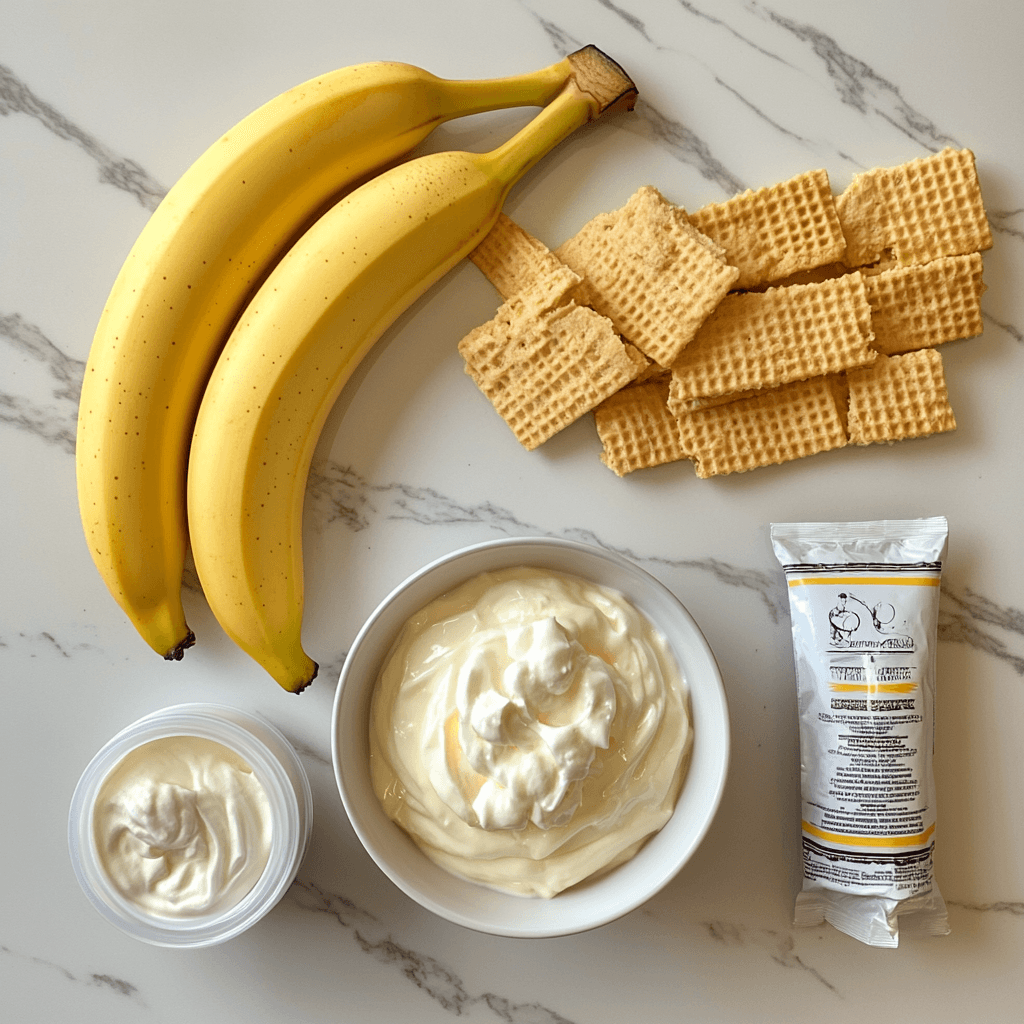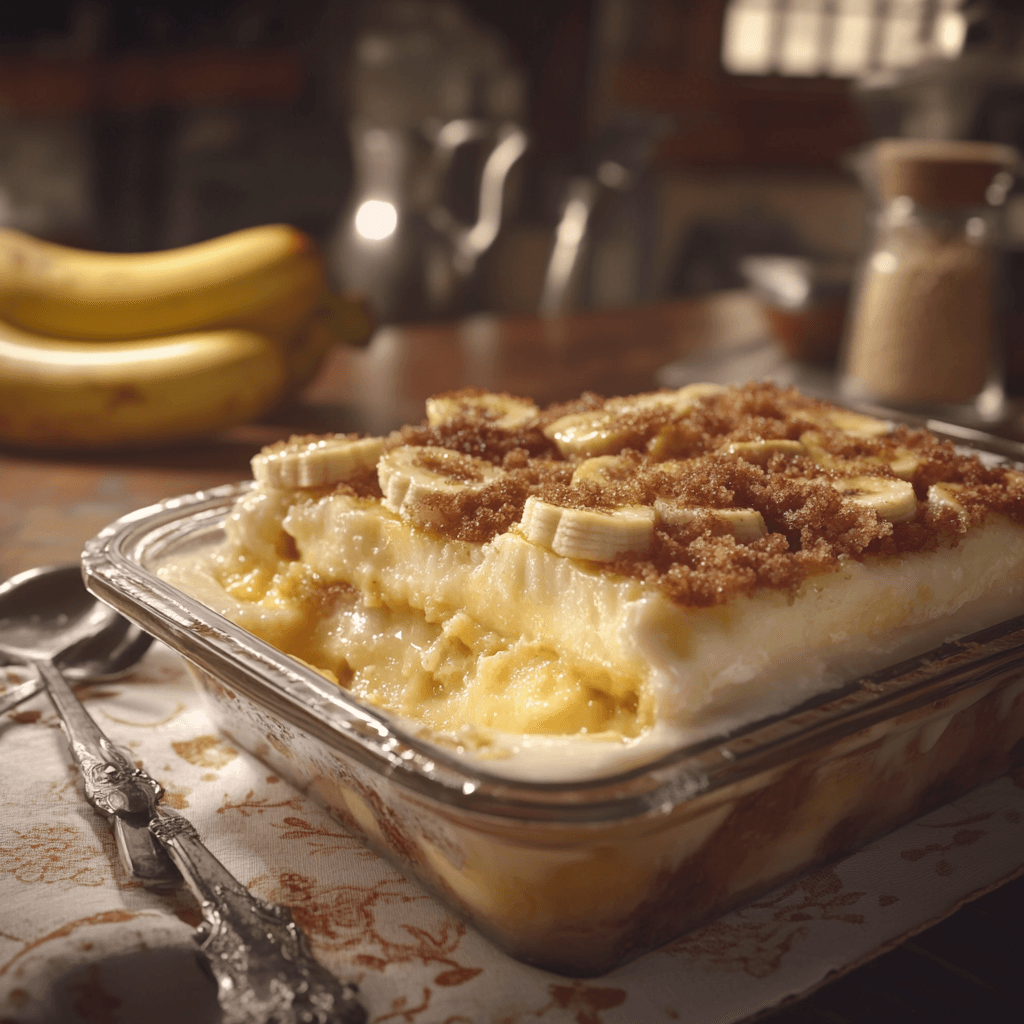Introduction

Magnolia Pudding is a creamy, indulgent dessert, typically associated with the South in American cuisine. Its name stems from the Magnolia Bakery in New York City, which popularized the modern version of this dessert in the late 20th century. Known for its layered composition and luscious texture, this pudding is now a staple in dessert offerings across the U.S.
Table of Contents
What is Magnolia Pudding?
At its core, Magnolia Pudding is a banana pudding dessert, but it often stands out due to its rich, homemade feel and emphasis on fresh, high-quality ingredients. It is prepared by layering vanilla pudding, fresh bananas, and Nilla wafers (or similar cookies), often topped with whipped cream or meringue. The dessert is refrigerated to allow the flavors to meld, resulting in a soft and cohesive texture.
Magnolia Bakery’s rendition uses sweetened condensed milk, a specific technique for pudding thickening, and a generous amount of whipped cream to give the dessert a light yet decadent mouthfeel.
Key Ingredients and Variations

Key Ingredients:
- Vanilla Pudding: Can be homemade or instant; gives the dessert its creamy base.
- Bananas: Sliced fresh, they add a fruity contrast to the rich pudding.
- Cookies: Traditionally Nilla wafers, but shortbread or graham crackers are sometimes used for variety.
- Sweetened Condensed Milk: Adds a rich sweetness and thickens the pudding.
- Whipped Cream: Freshly whipped cream elevates the texture and taste.
Popular Variations:
- Chocolate Magnolia Pudding: Adds cocoa or chocolate pudding for a richer flavor.
- Strawberry Banana Pudding: Incorporates fresh strawberries alongside bananas.
- Nut-Infused Pudding: Includes toasted nuts, like pecans or walnuts, for added crunch.
- Vegan Magnolia Pudding: Substitutes plant-based milk, vegan cookies, and coconut whipped cream for a dairy-free alternative.
- Caramel Drizzle: Some versions add caramel sauce for a touch of extra sweetness.
Historical Background of Magnolia Pudding
The roots of banana pudding trace back to the 19th century, influenced by English trifle recipes that featured custard, sponge cake, and fruit. It gained prominence in the Southern United States during the early 20th century when bananas became more widely available.
Magnolia Pudding, as it’s known today, owes much of its fame to Magnolia Bakery, which opened in 1996 in New York City’s West Village. Their take on banana pudding introduced a creamy, layered dessert that resonated with dessert enthusiasts. The bakery’s emphasis on nostalgia, combined with its innovative recipe, brought renewed attention to banana pudding, turning it into a gourmet phenomenon.
Magnolia Pudding continues to evolve, with chefs and home cooks alike experimenting with flavors and textures while staying true to its comforting essence.
Storage Basics for Magnolia Pudding
Magnolia Pudding, like most dairy- and fruit-based desserts, requires proper storage to maintain its freshness, flavor, and safety. This ensures the dessert retains its creamy texture while preventing spoilage and bacterial growth.
Why Proper Storage is Essential
- Preservation of Freshness:
- Magnolia Pudding contains perishable ingredients like dairy (pudding, whipped cream) and fresh bananas. Without proper storage, these components can degrade quickly, leading to unpleasant textures and off-flavors.
- Preventing Spoilage:
- Exposure to air and warm temperatures accelerates bacterial growth, particularly in dairy-based products. Proper storage helps prevent foodborne illnesses.
- Maintaining Aesthetic Appeal:
- Proper storage prevents the bananas from browning too quickly and helps the cookies retain a desirable, soft-but-not-mushy consistency.
The Role of Refrigeration in Preserving Desserts
Refrigeration is crucial for Magnolia Pudding for several reasons:
- Slows Down Bacterial Growth:
- Keeping the pudding at or below 40°F (4°C) inhibits the growth of harmful bacteria, such as Salmonella or Listeria, that thrive in room-temperature conditions.
- Preserves Texture:
- The layers in Magnolia Pudding—bananas, pudding, and cookies—meld together during refrigeration, creating the signature creamy texture. Without refrigeration, the pudding might separate or become overly runny.
- Enhances Flavor Integration:
- Storing the dessert in the refrigerator allows the flavors to develop and meld, ensuring a richer taste upon serving.
- Extends Shelf Life:
- With proper refrigeration in an airtight container, Magnolia Pudding can last 3-4 days, retaining its quality and safety.
Shelf Life Without Refrigeration
Without refrigeration, Magnolia Pudding has a very limited shelf life due to the high perishability of its ingredients:
- At Room Temperature (2-4 Hours):
- If left unrefrigerated, Magnolia Pudding should not sit out for more than 2-4 hours. Beyond this point, bacteria can grow rapidly, especially in warm conditions.
- Visual and Taste Changes:
- Bananas will brown and soften, whipped cream may deflate, and the pudding base could become runny or sour if not stored properly.
- Safety Concerns:
- Consuming unrefrigerated Magnolia Pudding after 4 hours poses a high risk of foodborne illnesses.
Storage Tips for Best Results
- Use Airtight Containers: Seal the pudding in a container to prevent odors from the fridge affecting its taste and to slow down oxidation.
- Layer Smartly for Longevity: Consider delaying the addition of bananas or whipped cream until just before serving, as these are the most perishable components.
- Avoid Freezing: While refrigeration is ideal, freezing can alter the pudding’s texture, causing the dairy to separate and bananas to become mushy upon thawing.
By adhering to these storage practices, you can enjoy Magnolia Pudding at its freshest and most flavorful!
Refrigeration Guidelines for Magnolia Pudding
Proper refrigeration is essential to maintain the quality, safety, and taste of Magnolia Pudding. Following recommended guidelines ensures this dessert remains enjoyable while preventing spoilage.
How Long Can Magnolia Pudding Stay Refrigerated?
- Optimal Shelf Life: Magnolia Pudding can last 3-4 days in the refrigerator when stored correctly in an airtight container.
- The flavors continue to meld during the first 24-48 hours, enhancing the overall taste and texture.
- After 3-4 days, the quality begins to decline, with the bananas browning and the pudding potentially becoming watery.
- Signs of Spoilage:
- Sour smell, discoloration, or separation in the pudding layers.
- Mold development on the surface.
The Right Temperature for Storing Magnolia Pudding
- Ideal Refrigeration Temperature: Keep the pudding at or below 40°F (4°C). This temperature slows bacterial growth and preserves freshness.
- Consistent Cooling: Ensure the refrigerator maintains a stable temperature by avoiding frequent door openings or overloading the shelves.
Refrigeration Dos and Don’ts
Dos:
- Use Airtight Containers:
- Store Magnolia Pudding in a well-sealed, food-safe container to prevent it from absorbing fridge odors or drying out.
- Refrigerate Immediately:
- Place the pudding in the refrigerator as soon as it’s prepared or served to prevent extended exposure to room temperature.
- Keep It on Middle Shelves:
- Store the dessert in the center of the fridge, where the temperature is most consistent.
- Label the Date:
- Mark the storage date on the container to keep track of freshness and consumption timelines.
Don’ts:
- Don’t Store in the Freezer:
- Magnolia Pudding’s texture can be ruined when frozen, as the dairy and pudding base may separate, and the bananas can become mushy upon thawing.
- Avoid Plastic Wrap Alone:
- Wrapping only with plastic wrap isn’t sufficient to protect against moisture loss or odor absorption.
- Don’t Store Near Strong Odors:
- Keep the pudding away from pungent items like onions or garlic to prevent it from absorbing unwanted flavors.
Pro Tip:
To prolong the dessert’s appeal, you can assemble the pudding in stages:
- Keep the pudding and whipped cream refrigerated separately.
- Add fresh banana slices and layer the dessert just before serving. This minimizes browning and ensures the freshest texture for your dessert.
By adhering to these refrigeration guidelines, Magnolia Pudding will stay fresh and delicious for days!
Signs Your Magnolia Pudding Has Gone Bad

While Magnolia Pudding is a delicious and comforting dessert, its perishable ingredients make it prone to spoilage if not stored properly. Recognizing the signs of spoilage is crucial for ensuring both quality and safety.
Key Indicators of Spoilage
- Unpleasant Odor:
- A sour or rancid smell is a strong indicator that the pudding has spoiled. Fresh Magnolia Pudding should have a sweet, mild aroma.
- Changes in Texture:
- Watery or Separated Layers: Spoilage may cause the pudding to become excessively runny or for the whipped cream and pudding layers to separate.
- Slimy Film: A slimy consistency on the surface or between layers suggests bacterial growth.
- Discoloration:
- Bananas: Fresh banana slices will brown naturally over time, but excessive browning or blackening signals that the pudding is no longer fresh.
- Pudding or Whipped Cream: Any green, blue, or pink discoloration could indicate mold growth.
- Mold Growth:
- Visible mold on the pudding, whipped cream, or bananas is a clear sign of spoilage. Discard the dessert immediately if you spot mold.
- Off Taste:
- A tangy, bitter, or otherwise off-putting taste indicates that the pudding has gone bad.
Health Risks of Consuming Spoiled Magnolia Pudding
Eating spoiled Magnolia Pudding can lead to foodborne illnesses caused by bacteria like Salmonella, E. coli, or Listeria. Symptoms may include:
- Nausea and Vomiting
- Diarrhea
- Abdominal Pain and Cramping
- Fever and Headache
In severe cases, particularly for those with weakened immune systems, the elderly, pregnant women, or young children, foodborne illnesses can have serious health implications. Always err on the side of caution and avoid consuming pudding that shows signs of spoilage.
Best Practices to Avoid Spoilage
- Store Properly:
- Use airtight containers and refrigerate immediately after preparation or serving.
- Keep the refrigerator at or below 40°F (4°C).
- Monitor Storage Time:
- Consume Magnolia Pudding within 3-4 days of preparation for the best quality and safety.
- Discard any leftovers after this time frame, even if no obvious signs of spoilage are present.
- Assemble Close to Serving Time:
- To minimize the browning of bananas and the softening of cookies, assemble the dessert shortly before serving or store the components separately.
- Practice Good Hygiene:
- Use clean utensils and hands during preparation to reduce the risk of introducing bacteria into the dessert.
- Avoid Cross-Contamination:
- Keep the pudding away from raw or strong-smelling foods in the refrigerator.
By following these guidelines and staying vigilant for signs of spoilage, you can enjoy Magnolia Pudding safely and at its freshest!
FAQs About Magnolia Pudding Storage
Why is banana pudding so good?
1. Does Magnolia Pudding Need to Be Refrigerated Overnight?
Yes, Magnolia Pudding must be refrigerated overnight to maintain its freshness and safety. The pudding contains dairy products and fresh fruit, which are highly perishable. Refrigeration ensures the dessert remains safe to consume and allows the flavors to meld, improving the texture and taste.
2. Can I Leave Magnolia Pudding Out for a Few Hours?
You can leave Magnolia Pudding at room temperature for a maximum of 2-4 hours, depending on the ambient temperature. Beyond this time frame, the risk of bacterial growth increases significantly, especially in warm conditions. For safety, refrigerate the pudding promptly after serving.
3. How Does Adding Fresh Fruit Impact Storage Requirements?
Adding fresh fruit, such as bananas or strawberries, shortens the pudding’s shelf life due to the fruit’s tendency to spoil quickly. Bananas, for example:
- Brown rapidly and may develop an unappealing texture after 24-48 hours.
- Increase the need for airtight storage to slow oxidation. To extend the dessert’s appeal, consider adding fresh fruit right before serving.
4. What Happens If I Forget to Refrigerate Magnolia Pudding?
If Magnolia Pudding is left unrefrigerated for more than 4 hours (or 2 hours in hot climates):
- The dessert is no longer safe to eat due to the potential for rapid bacterial growth.
- Ingredients like dairy, whipped cream, and fruit can spoil, leading to sour smells, watery textures, and a risk of foodborne illnesses. In this case, it’s best to discard the pudding.
5. Is Refrigeration Necessary for All Magnolia Pudding Recipes?
Yes, refrigeration is necessary for all Magnolia Pudding recipes that use perishable ingredients like:
- Dairy-based puddings or whipped cream
- Fresh fruits like bananas
- Ingredients that spoil at room temperature However, some vegan or shelf-stable versions (using plant-based milk and no fresh fruit) may last longer without refrigeration. Always check specific recipe recommendations.
6. How to Safely Store Magnolia Pudding in a Hot Climate?
In hot climates, Magnolia Pudding is especially prone to spoilage. Here are some tips for safe storage:
- Immediate Refrigeration: Transfer the pudding to the refrigerator as soon as possible, ideally within 1 hour of preparation or serving.
- Insulated Containers: If transporting the dessert, use an insulated cooler with ice packs to keep it cold.
- Limit Exposure: Avoid prolonged exposure to temperatures above 40°F (4°C), even during serving.
- Shorter Shelf Life: Consume the dessert within 2-3 days for optimal safety and quality in warmer environments.
Key Takeaway
Proper storage is crucial for Magnolia Pudding, especially considering its perishable ingredients. Follow refrigeration guidelines and minimize exposure to heat to enjoy the dessert safely and at its best!
Conclusion: Storing Magnolia Pudding Safely and Enjoyably
Magnolia Pudding is a delightful dessert that combines creamy textures and sweet flavors, making it a favorite for many. However, its perishable nature demands proper storage to ensure both safety and taste. Following refrigeration guidelines is crucial to preserve its freshness, maintain its rich layers, and prevent foodborne illnesses.
Revisiting the Importance of Refrigeration for Magnolia Pudding
- Ensures Safety: Refrigeration inhibits bacterial growth, keeping the pudding safe for consumption over several days.
- Preserves Quality: Proper cold storage helps maintain the dessert’s creamy consistency and prevents unpleasant texture changes like separation or sliminess.
- Extends Shelf Life: By keeping Magnolia Pudding at or below 40°F (4°C), you can enjoy it for up to 3-4 days without compromising flavor or safety.
- Maintains Aesthetic Appeal: Refrigeration slows banana browning and keeps layers cohesive, ensuring the pudding looks as good as it tastes.
Final Tips for Enjoying Fresh, Delicious Magnolia Pudding
- Store Airtight: Always use sealed containers to lock in freshness and prevent odors from the fridge affecting the pudding’s flavor.
- Serve Promptly: Only take out as much pudding as you plan to serve, returning the remainder to the fridge immediately.
- Layer Strategically: To keep the dessert at its peak, consider adding fresh fruit or whipped cream just before serving.
- Monitor Freshness: Enjoy Magnolia Pudding within the recommended 3-4 days, discarding any leftovers beyond this period.
- Plan Ahead in Hot Climates: Use insulated coolers for transport and limit exposure to warm temperatures during serving or events.
By following these guidelines, you can savor the creamy, nostalgic goodness of Magnolia Pudding while ensuring it remains fresh, safe, and utterly delicious.
